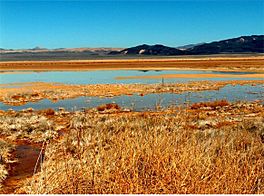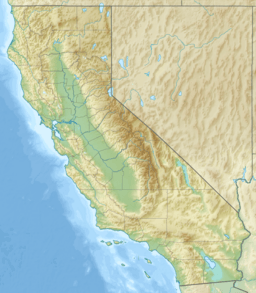Harper Lake facts for kids
Quick facts for kids Harper Lake |
|
|---|---|

Harper Dry Lake Marsh, diminished by years of agricultural diversion
|
|
| Location | Mojave Desert San Bernardino County, California |
| Coordinates | 35°01′50″N 117°17′24″W / 35.0305°N 117.2900°W |
| Lake type | Endorheic basin |
| Basin countries | United States |
| Max. length | 16 km (9.9 mi) |
| Max. width | 7 km (4.3 mi) |
| Shore length1 | 45 km (28 mi) |
| Surface elevation | 617 m (2,024 ft) |
| Settlements | Lockhart, California |
| 1 Shore length is not a well-defined measure. | |
Harper Lake is a dry lake located in the Mojave Desert in Southern California. It's found near the small community of Lockhart, California, in the northwestern part of San Bernardino County. You can get to the lake from Harper Lake Road, which is off California State Route 58 between Boron and Barstow.
Contents
What Was Harper Lake Like?
Long ago, Harper Lake was a real lake with water. It was about 658 metres (2,159 ft) (2,159 feet) above sea level. The lake covered a large area of about 255 square kilometres (98 sq mi) (98 square miles).
Animals That Lived in the Lake
Many creatures lived in Harper Lake when it was full of water. These included minnows (a type of small fish), molluscs (like snails and clams), and ostracods. Ostracods are tiny crustaceans, often called "seed shrimp."
Scientists have found different kinds of ostracods in the lake bed. These tiny fossils tell us that the lake was made of fresh water. It likely had water flowing into it during certain seasons. Some parts of the lake were also quite shallow.
Shape of the Ancient Lake
When the lake was full, a long piece of land stuck out into it from the western side. Smaller land areas also jutted into the lake from the north and south. We know the lake existed because of blue clay found deep in the ground. Also, fine mud and sand were found on the old lake shores.
History of Harper Lake
Harper Lake has been around for a very long time. The oldest shorelines found are from about 24,400 to 25,000 years ago. Some evidence suggests the lake was even older, possibly 40,000 to 45,000 years ago.
The Mojave River's Connection
For many thousands of years, the Mojave River sometimes flowed into Harper Lake. This was between 40,000 and 45,000 years ago. At other times, the river flowed into Lake Manix, which is farther downstream. The Mojave River first started flowing into Harper Lake about 475,000 to 575,000 years ago. It then began to switch between Harper Lake and Lake Manix around 500,000 years ago. The last time the Mojave River might have reached Harper Lake was between 20,000 and 25,000 years ago.
How Harper Lake Became a Dry Lake
Harper Lake had water and a natural marsh (a type of wetland) until the early 1900s. But then, farms started to use a lot of the groundwater nearby. This groundwater was what kept the lake full. As the water was used up, the lake began to shrink.
The lake and marsh were very important for wildlife. Many migrating birds visited this oasis habitat. It also supported many desert animals. Even as the lake shrank, a small part of it in the southwest corner remained a marsh. This was kept alive by a little bit of water runoff from nearby farms. This small habitat continued to support wildlife into the early 1990s.
Harper Lake Today
Today, Harper Lake is a playa, which means it's a dry lake bed. It sits about 615 metres (2,018 ft) (2,018 feet) above sea level. The area around the lake bed has a dry climate with desert scrub plants. The land around the lake is mostly made of alluvial fans, which are fan-shaped deposits of sand and gravel. These lie on top of older basalt rocks.
Why the Lake Dried Up
The lake became completely dry, and the marsh died in the late 1990s. This happened after an alfalfa farm next to the lake closed down. When the farm stopped, the water that helped sustain the marsh was no longer there. This caused the number of migrating and local wildlife to drop.
Later, a new solar power plant was built west of the lake. The plant was supposed to pump groundwater to the lake to help restore it. However, the company that owned the plant went bankrupt, so this didn't happen. After the company's issues were sorted out, other problems came up. Edwards Air Force Base was worried about bird strikes (birds flying into aircraft). These and other official issues stopped the restoration efforts for a while.
Efforts to Restore Harper Lake
Even with the problems, the new owners of the Solar Energy Generating Systems power plant, Luz Solar Partners and NextEra Energy Resources, started delivering water to the lake. They did this because the Bureau of Land Management (BLM) asked them to.
In 2005, a group called Friends of Harper Lake asked the BLM and the California Energy Commission for help. They approved changes to the project. Now, up to 75 acre-feet (93,000 m3) of water each year will be managed by the BLM. This water will be sent to the lake as part of an agreement to make up for expanding the solar field.
Other Events at Harper Lake
On March 25, 2009, an F-22 Raptor jet crashed on the dry lakebed. Sadly, a test pilot from Lockheed Martin died in the accident.



